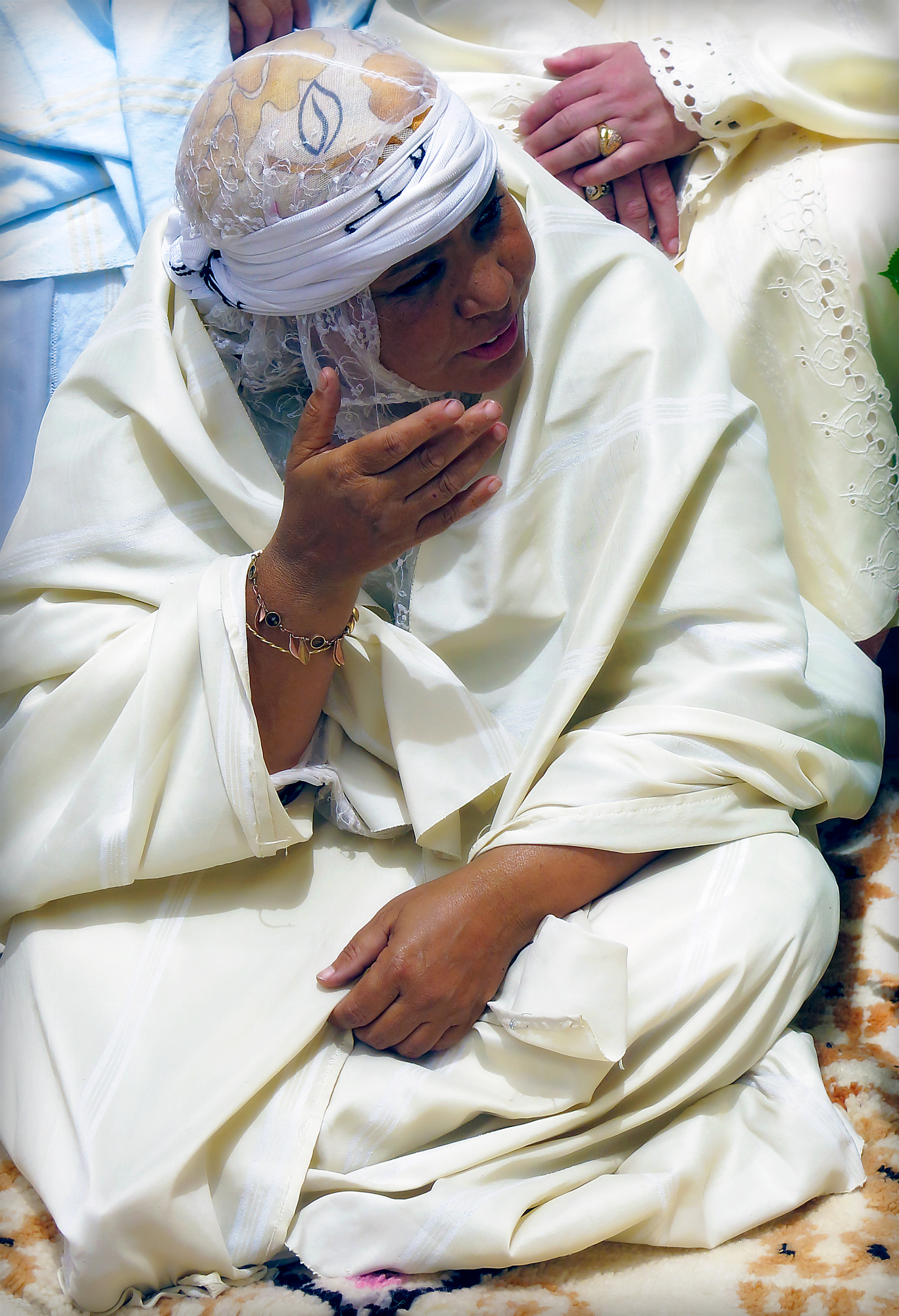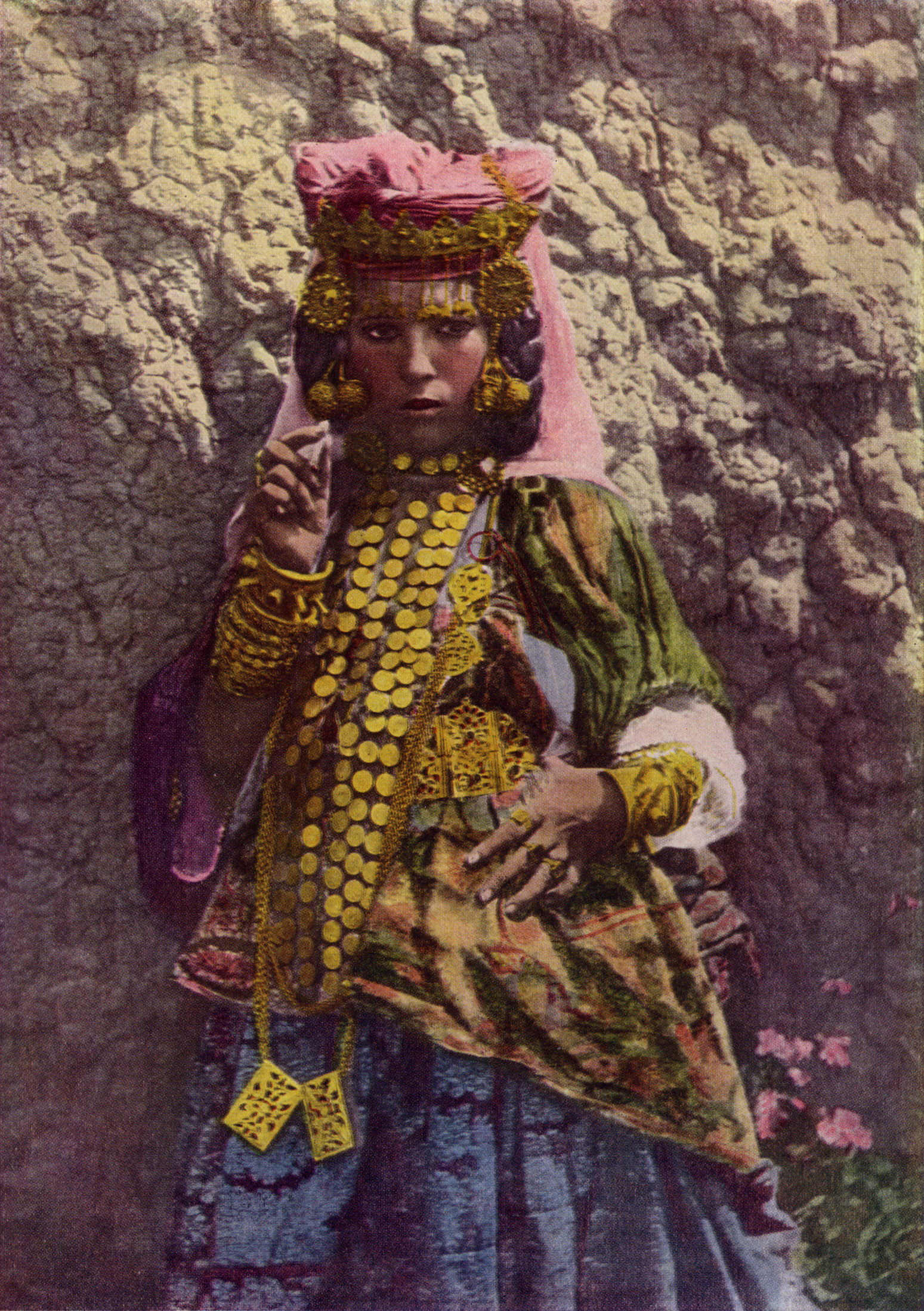Ouled Naïl on:
[Wikipedia]
[Google]
[Amazon]
The Ouled Naïl (; ) are an
 The Ouled Naïl are seminomadic or
The Ouled Naïl are seminomadic or  The Ouled Naïl have traditionally reared cattle as nomads in their mountain grasslands, as well in the northern Hodna region and the Dayas in the south. When they are nomadic they live in black-and-red striped tents, but they also used to live in ''dechra'', or non fortified villages, or in ksour, fortified ones. Cereal cultivation is possible in the mountain heights, although with rather irregular results. They rarely were able to cultivate
The Ouled Naïl have traditionally reared cattle as nomads in their mountain grasslands, as well in the northern Hodna region and the Dayas in the south. When they are nomadic they live in black-and-red striped tents, but they also used to live in ''dechra'', or non fortified villages, or in ksour, fortified ones. Cereal cultivation is possible in the mountain heights, although with rather irregular results. They rarely were able to cultivate
A Brief Encounter with the Historical Ouled NailImages of the Ouled NailEtienne Dinet and the Ouled Naïl
* tp://ftp.fao.org/docrep/fao/010/a1250e/annexes/CountryReports/Algeria.pdf FAO country reports: Algeria {{DEFAULTSORT:Ouled Nail Arab tribes in Algeria Atlas Mountains
Arab
Arabs (, , ; , , ) are an ethnic group mainly inhabiting the Arab world in West Asia and North Africa. A significant Arab diaspora is present in various parts of the world.
Arabs have been in the Fertile Crescent for thousands of years ...
tribal confederation living in the Ouled Naïl Range, Algeria
Algeria, officially the People's Democratic Republic of Algeria, is a country in the Maghreb region of North Africa. It is bordered to Algeria–Tunisia border, the northeast by Tunisia; to Algeria–Libya border, the east by Libya; to Alger ...
. They are found mainly in Bou Saâda, and Djelfa, but there is also a significant number of them in Ghardaïa
Ghardaïa (, ) is the capital city of Ghardaïa Province, Algeria. The commune of Ghardaïa has a population of 93,423 according to the 2008 census, up from 87,599 in 1998, with an annual growth rate of 0.7%.
It is located in northern-central A ...
.
Origins
The oral lore of the Ouled Naïl people claims ancientArab
Arabs (, , ; , , ) are an ethnic group mainly inhabiting the Arab world in West Asia and North Africa. A significant Arab diaspora is present in various parts of the world.
Arabs have been in the Fertile Crescent for thousands of years ...
descent from tribes that arrived in the area about a thousand years ago. They trace their origin back to Sidi Naïl, an Arab marabout
In the Muslim world, the marabout () is a Sayyid, descendant of Muhammad (Arabic: سـيّد, Romanization of Arabic, romanized: ''sayyid'' and ''sidi'' in the Maghreb) and a Islam, Muslim religious leader and teacher who historically had the f ...
and sharif
Sharīf or Sherif (, 'noble', 'highborn'), also spelled shareef, feminine sharīfa (), plural ashrāf (), shurafāʾ (), or (in the Maghreb) shurfāʾ, is a title used to designate a person descended, or claiming to be descended, from the fami ...
(descendent of Muhammad
Muhammad (8 June 632 CE) was an Arab religious and political leader and the founder of Islam. Muhammad in Islam, According to Islam, he was a prophet who was divinely inspired to preach and confirm the tawhid, monotheistic teachings of A ...
) who settled in central Algeria in the 16th century. Some traditions trace their ancestry to the Banu Hilal
The Banu Hilal () was a confederation of Arab tribes from the Najd region of the central Arabian Peninsula that emigrated to the Maghreb region of North Africa in the 11th century. They ruled the Najd, and campaigned in the borderlands between I ...
of Najd
Najd is a Historical region, historical region of the Arabian Peninsula that includes most of the central region of Saudi Arabia. It is roughly bounded by the Hejaz region to the west, the Nafud desert in Al-Jawf Province, al-Jawf to the north, ...
, who came to the highlands through El Oued
El Oued (), Souf or Oued Souf is a city, and the capital of El Oued Province, in Algeria. The oasis town is watered by an underground river, hence its name is El Oued which enables date palm cultivation and the rare use (for the desert) of brick c ...
, Ghardaia.
Traditional lifestyle
 The Ouled Naïl are seminomadic or
The Ouled Naïl are seminomadic or nomadic
Nomads are communities without fixed habitation who regularly move to and from areas. Such groups include hunter-gatherers, pastoral nomads (owning livestock), tinkers and trader nomads. In the twentieth century, the population of nomadic pa ...
people living in the highlands of the range of the Saharan Atlas to which they gave their name. The town of Djelfa has been traditionally an important market and trade centre for the Ouled Naïl, especially for their cattle. The town has cold and long winters with temperatures averaging 4 °C. In recent years Djelfa Province
Djelfa () is a province (''wilaya'') of Algeria. Its capital is Djelfa.
It was first established by the administrative reorganization of 1974, and is home to over 1,595,794 inhabitants. Localities in this province include Tadmit, El Khemis, a ...
has become one of the most populated provinces of the Hauts-Plateaux with a population of 1,164,870.
 The Ouled Naïl have traditionally reared cattle as nomads in their mountain grasslands, as well in the northern Hodna region and the Dayas in the south. When they are nomadic they live in black-and-red striped tents, but they also used to live in ''dechra'', or non fortified villages, or in ksour, fortified ones. Cereal cultivation is possible in the mountain heights, although with rather irregular results. They rarely were able to cultivate
The Ouled Naïl have traditionally reared cattle as nomads in their mountain grasslands, as well in the northern Hodna region and the Dayas in the south. When they are nomadic they live in black-and-red striped tents, but they also used to live in ''dechra'', or non fortified villages, or in ksour, fortified ones. Cereal cultivation is possible in the mountain heights, although with rather irregular results. They rarely were able to cultivate date palm
''Phoenix dactylifera'', commonly known as the date palm, is a flowering-plant species in the palm family Arecaceae, cultivated for its edible sweet #Fruits, fruit called dates. The species is widely cultivated across North Africa, northern A ...
s in the heights but obtained dates from other areas by trading, especially in Bou Saâda located at the feet of the northern end of the mountain range.
Despite the harsh conditions of the dry and cold highlands where they live, this ethnic group has managed to fare fairly well in their traditional environment along the centuries. However, the odd years of drought
A drought is a period of drier-than-normal conditions.Douville, H., K. Raghavan, J. Renwick, R.P. Allan, P.A. Arias, M. Barlow, R. Cerezo-Mota, A. Cherchi, T.Y. Gan, J. Gergis, D. Jiang, A. Khan, W. Pokam Mba, D. Rosenfeld, J. Tierney, ...
and years with prolonged, cold winters are disastrous for the Ouled Nail; in 1944, and again in 1947, when weather conditions were especially rough, about 50% of their livestock died and famine
A famine is a widespread scarcity of food caused by several possible factors, including, but not limited to war, natural disasters, crop failure, widespread poverty, an Financial crisis, economic catastrophe or government policies. This phenom ...
s followed.
Dances and songs
The Ouled Naïl tribe originated a style of music, sometimes known as Bou Saâda music after the town near their homeland. In belly dancing, the term refers to a style of dance originated by the Ouled Naïl, noted for their way of dancing. Although their primary roles and activities in their rural milieu were connected with animal farming, most women trained in the art of dance and song from childhood. Thus for Ouled Naïl females the practice of leaving their ancestral home and settling in a nearby desert town as entertainers was common. This was especially so in times of disaster and famine, when a woman had relative freedom to fend for herself in order to survive, save money and improve her future economic status."Exotic" representations
The 1956 edition of theMichelin Guide
The ''Michelin Guides'' ( ; ) are a series of guide books that have been published by the French tyre company Michelin since 1900. The ''Guide'' awards up to three Michelin star (classification), stars for excellence to a select few restaurants ...
devotes only a few lines to the Ouled Naïl mountain region; Djelfa is not even mentioned and the Ouled Naïl people are "mere courtesan
A courtesan is a prostitute with a courtly, wealthy, or upper-class clientele. Historically, the term referred to a courtier, a person who attended the court of a monarch or other powerful person.
History
In European feudal society, the co ...
s and Oriental dancers".
French colonialist representations of the Ouled Naïl concentrated almost exclusively on women who temporarily left their home and settled in some nearby town. However, none of the highland tribes to which they belonged were specialised in prostitution and only some Ouled Naïl women became dancers. A British traveller, Lawrence Morgan, gave an account of his experiences living with the Ouled Naïl which focuses on the lives of the dancers. title= Flute of Sand, by Lawrence Morgan, publisher=Odhams Press, London, 1956. Still, the exuberance of their ornaments and the exoticism of their costumes added to the general fascination.
Auguste Maure, an orientalist photographer that lived in Biskra
Biskra () is the capital city of Biskra Province, Algeria. In 2007, its population was recorded as 307,987. Biskra is located in northeastern Algeria, about from Algiers, southwest of Batna, Algeria, Batna and north of Touggourt. It is nickna ...
was active from 1860 to 1907 and took many photographs of landscapes and cities of south Algeria ( El Kantara, Sidi Okba
Sidi Okba () is a Communes of Algeria, commune in the Biskra Province, Algeria. It was named after the Muslim General Uqba ibn Nafi who died there in 683 AD. The nearest big city is Biskra which is located 18 km away.
Sidi Okba sits on an oas ...
, Chetma, Tilatou, Tolga, Touggourt
Touggourt (; or 'the gate') is a city and Communes of Algeria, commune, former sultanate and capital of Touggourt District, in Touggourt Province, Algeria, built next to an oasis in the Sahara. As of the 2008 census, the commune had a population ...
). The female members of the Ouled Naïl tribe, wearing the traditional colorful costumes and covered by jewels, were often represented on Maure photographs which were appreciated by tourists.
In the 1930s, painter Juanita Guccione lived among the Ouled Naïl people, and she used the experience as inspiration for some of her work.
See also
* Bou Saâda * Djelfa * Auguste Maure * Nasreddine Dinet * The Finale of the orchestral Suite '' Beni Mora'' byGustav Holst
Gustav Theodore Holst (born Gustavus Theodore von Holst; 21 September 1874 – 25 May 1934) was an English composer, arranger and teacher. Best known for his orchestral suite ''The Planets'', he composed many other works across a range ...
is titled ''In the Street of the Ouled Naïls''.
References
External links
*A Brief Encounter with the Historical Ouled Nail
* tp://ftp.fao.org/docrep/fao/010/a1250e/annexes/CountryReports/Algeria.pdf FAO country reports: Algeria {{DEFAULTSORT:Ouled Nail Arab tribes in Algeria Atlas Mountains